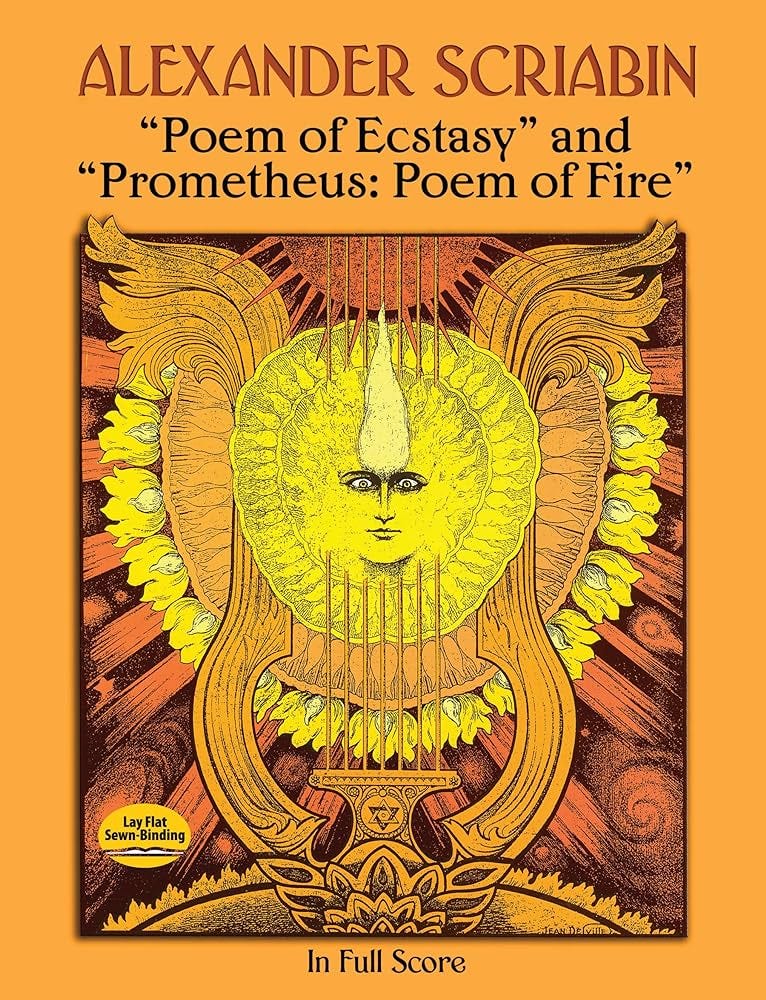A Singular Symphonic Experience
The composer Alexander Scriabin intended his 20-minute orchestral “tone poem” Prometheus: The Poem of Fire (1911) to be accompanied by a light show. Born in 1872 in Moscow, Scriabin is said to have had synesthesia—a condition in which the stimulation of one sense provokes a reaction in another. In his case, he saw specific colors when he heard specific keys (e.g., C=red, D=green, E=purple, and so on), and the light show was meant to illustrate to listeners the colors he supposedly saw as the piece was played. (Scriabin’s synesthesia is a major part of his lore, but there’s evidently a lot of skepticism among scholars that he actually had the condition.)
Following in Richard Wagner’s footsteps, Scriabin aspired toward a Gesamtkunstwerk: a “total artwork” that would make use of multiple senses. Wikipedia helpfully notes that “his unrealized magnum opus Mysterium was to be a weeklong performance including music, scent, dance, and light in the foothills of the Himalayas that was somehow to bring about the world's dissolution in bliss.”
This weekend, the San Francisco Symphony is putting on a quasi-Gesamtkunstwerk version of Prometheus. I went on Saturday night, when there was a circular lighting rig above the orchestra and various light fixtures along the walls of the auditorium that changed colors—which honestly did not do much, as it basically looked like a large-scale screensaver. More interestingly, the music was accompanied by three scents—at the piece’s start, its climax, and its denouement. The program came with an “olfactory score”—as in, “sheet music”—that traced the fragrance narrative from earthy to fiery to hopeful. (The perfumer for the event was Mathilde Laurent, who is a “nose” for Cartier.) It was an exceptional experience—not just because it was my first time experiencing scent as part of a musical performance, but because it recalls an era when composers seemed to have a much grander vision of an orchestra’s possibilities.
You can read more about the development of the concert here, and if you’re in town, there will be one more performance, on Sunday afternoon.
-Inkoo
Jon Stewart Knows The Daily Show Can’t Save Democracy. I wrote about my surprise at being so delighted by Stewart’s return, after dreading it for weeks. I also took stock of The Daily Show’s ever-increasing influence, and what that looks like in 2024.
In Shōgun, an Update Is a Double-Edged Sword. My review of a TV adaptation that tries to make a story about an English sailor-turned-samurai in 17th-century Japan more palatable for 21st-century audiences.
A Marketplace of Girl Influencers Managed by Moms and Stalked by Men. We should have all taken the revelation that many Silicon Valley execs don’t give their children free rein online a lot more seriously. This is a blood-boiling exposé about how Meta is fully aware of its pedophile problem and doing pretty much nothing about it. The “twist” now is that a new breed of stage moms who want their daughters to become social-media stars are indulging many of those pedophiles’ desires (and demands!) for the sake of likes and follower counts.
The Secret to True Detective’s Appeal Isn’t the Mysteries. On a much lighter note, I enjoyed Laura Miller’s ode to pop culture’s greatest couples: detective partners.
Two podcast interviews with Kara Swisher about her new memoir, Burn Book. I’m not a Swisher fangirl and initially had zero interest in reading her book. But I enjoyed the hell out of her chat with David Remnick on The New Yorker Radio Hour and her hilariously elbowy appearance on Hard Fork, a NY Times tech podcast. Both interviews were helped enormously by the fact that Swisher has known Remnick and the Hard Fork guys for years, if not decades. They fold you into their friendships immediately, and, as a result, the conversations feel so much warmer and more insightful than most author interviews.




